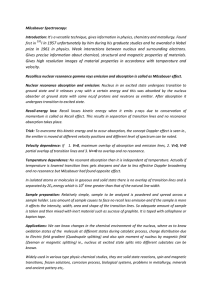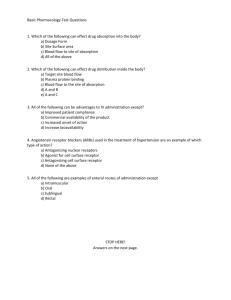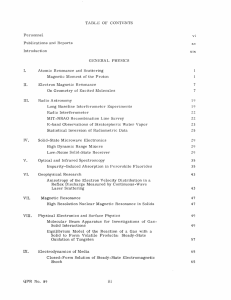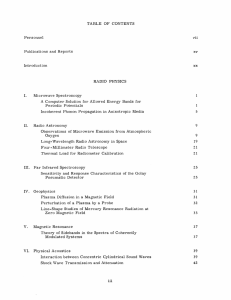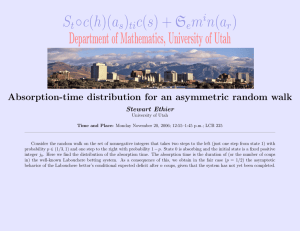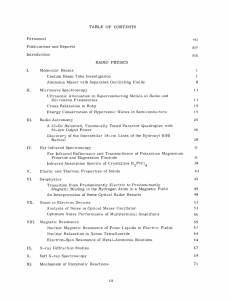Electron Cyclotron Wave Propagation and G.
advertisement
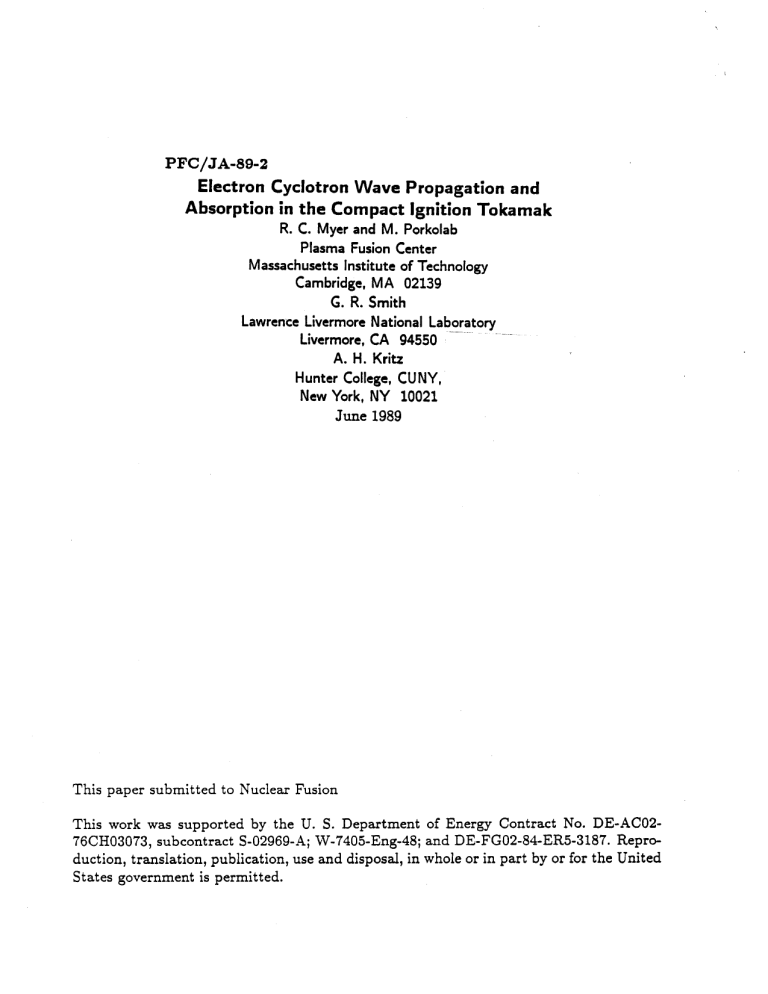
PFC/JA-89-2
Electron Cyclotron Wave Propagation and
Absorption in the Compact Ignition Tokamak
R. C. Myer and M. Porkolab
Plasma Fusion Center
Massachusetts Institute of Technology
Cambridge, MA 02139
G. R. Smith
Lawrence Livermore National Laboratory
Livermore, CA 94550
A. H. Kritz
Hunter College, CUNY,
New York, NY 10021
June 1989
This paper submitted to Nuclear Fusion
This work was supported by the U. S. Department of Energy Contract No. DE-AC0276CH03073, subcontract S-02969-A; W-7405-Eng-48; and DE-FG02-84-ER5-3187. Reproduction, translation, publication, use and disposal, in whole or in part by or for the United
States government is permitted.
Electron Cyclotron Wave Propagation and Absorption
in the Compact Ignition Tokamak
Richard C. Myer and Miklos Porkolab
Plasma Fusion Center, Massachusetts Institute of Technology
Cambridge, MA 02139
Gary R. Smith
Lawrence Livermore National Laboratory, University of California
Livermore, CA 94550
Arnold H. Kritz
Hunter College/CUNY, New York, NY 10021
Abstract
The possibility of heating the Compact Ignition Tokamak (CIT) with electron-cyclotron power at 280 GHz (fundamental cyclotron resonance) is examined by simple analytic
estimates and by detailed computational means. Efficient single-pass absorption of the
0-mode polarization is accomplished by scanning the angle of injection of the microwave
power from 60* to 90* relative to the toroidal magnetic-field direction as the field intensity
is ramped from 7 or 8 to 10 T and the volume-average beta increases from 0.4% to 2.8%.
Efficient absorption occurs for the range of central densities from 2 to 8 x 10 2 0m- 3 and
central temperatures from 5 to 20 keV. Thus, electron-cyclotron-resonance heating, using
either gyrotrons or free-electron lasers, offers a reasonable heating scenario from the ohmic
phase to the ignition phase even with a single-frequency RF source.
I. Introduction
The most recent operating scenario of the Compact Ignition Tokamak (CIT) calls for
ramping of the toroidal magnetic field from 7.0 or 8.0 to 10.0 T in a few seconds, followed
by a burn cycle and a ramp-down cycle. Simultaneously, the plasma must be heated from
an initial low-beta equilibrium ( : 0.44% at 7.0 to 8.0 T) to a final burn equilibrium in
the range of 2.5-5.0%, having 10.0 T on the magnetic axis [1]. Since the toroidal plasma
current will be ramped at the same time and since the available time for fiat-tp magnetic
field must be reserved for the burn cycle, it is imperative that densification and heating be
1
carried out as the magnetic field is ramped. At first it would appear that this requirement
will either restrict deployment of possible RF heating techniques (ICRF, ECRH) to ones
which allow continuous sweeping of the source frequency, or force one to accept an operating
scenario in which the resonance is swept from the high-magnetic-field side to the low-field
side as the magnetic field on axis increases. The former approach places severe demands
on RF source technology (dynamically tunable sources at high power are hard to come
by in either the ICRF or ECRH regime, with the possible exception of free-electron lasers
(FELs)). The latter approach possibly leads to non-optimal confinement because it cannot
achieve the desired heating profiles. In the case of swept frequencies, further difficulties
may arise with certain elements of the transmission line (tuning elements in the case of
ICRF are frequency sensitive, while windows, polarizers, etc., for ECRH may be frequency
dependent).
Here we examine an alternative approach which is applicable to ECR heating, using
either gyrotrons or FELs. The frequency remains constant, while the angle of injection is
varied by simply rotating a reflecting mirror placed in the path of the incident microwave
beam. The rotating mirror permits one to launch waves with sufficiently high N11 so that
the Doppler broadened resonance of particles on the magnetic axis with 7.0-8.0 T can
provide adequate absorption. In contrast to the heating scenarios recently proposed which
rely on downshifted frequencies and finite N11 to ensure penetration and absorption of the
extraordinary mode (X-mode, ERF.LB) polarization for frequencies below the fundamental
[2], here we propose to use an upshifted frequency with finite N11 for the ordinary mode
(0-mode, .ffRFJIf) polarization. The 0-mode is accessible from the outside (low-field side)
of the torus provided the density is such that w,, < w k fl, (max). The advantage of
heating above the fundamental cyclotron frequency initially is that as the field is ramped
absorption near the center can be maintained, even when the field is at its maximum. As
the resonance layer moves toward the magnetic axis the rotating mirror can sweep the beam
toward perpendicular to reduce the Doppler width and avoid heating the plasma edge. At
B(Q) = 10.0 T the beam will be at normal incidence with strong absorption immediately
on the high-field side of the resonance. Considering f = 280 GHz for a central heating
at B(0) = 10.0 T, the maximum cut-off density is at neit ; 9.7 x 1020 m-3 . We expect
reasonable wave penetration and heating up to 0.9ncri or ne(0) = 8.7 x 10 20 m-3 which is
about the maximum central density in CIT. On account of the Murakami density limit [1],
CIT is expected to operate at ft : 5 x 102 0 m-3 at B = 10.0 T (R = 2.1 m, a = 0.70 m, r =
2.0, I, ; 10 MA). At lower magnetic fields, beta and hence the density is expected to be
lower and no wave penetration problems should be anticipated. In addition to its simplicity,
this technique requires rotation of the beam injection angle only in the toroidal direction.
2
Furthermore, the propagating rays and the absorption profiles are not excessively sensitive
to the angle of injection (as long as the density is not near the cut-off value).
The alternate technique proposed by the authors of Reference 2 enjoy the advantage
of lower frequency (200 GHz vs. 280 GHz proposed here). However, there are several
disadvantages of using lower frequencies when applied to heating compact ignition devices:
(a) Only the top-launch scenario was useful for heating while ramping the magnetic field,
density and current. However in such a launching scenario, the absorption profile is
very sensitive to the exact launching angle (both in the poloidal and toroidal direction,
especially at higher densities). Such a control of ray trajectories may be made more
difficult if we consider scattering by low frequency density fluctuations at the plasma
periphery. Consequently, sawtooth activity control by precise control of the radial
power deposition profile may be difficult.
(b) Lack of easy access to the top (bottom) of the vacuum chamber in the presence of
divertors is a serious drawback of such a technique, especially if one has to install,
and maintain reflecting mirrors in a burning plasma environment. Further difficulties
may arise if one considers moving parts with two degrees of freedom.
(c) There is the potential of RF breakdown in the beam-line (path) where the W = We
resonance surface is crossed, which is inherent in the low frequency scenario.
We note that recent advances in source technology (gyrotrons and FELs) make ECR
heating of CIT at 280 GHz a viable option. Furthermore, ECRH is also attractive from
the point of high-power-density transmission (Power/Area Z 100 MW/m 2 so that 30 MW
of ECR power may be transmitted through two CIT ports with dimensions of 0.40 x 1.0 m
each). Quasi-optical transmission techniques may be utilized at 280 GHz so that no internal
antenna structure (with the exception of the rotating mirror placed in the port) is required,
a definite advantage over other techniques of heating a burning plasma. Equilibration of
temperature between electrons and ions (req) is expected to be significantly shorter than
typical energy confinement times, rE. For example, at n, a 1.0 x 10 2 0 3 , T.. = 5 keV
60 msec, while at
(low-beta equilibrium), and assuming Zef :t 1.5 we estimate -r.q
n (0) ; 8 x 10 2 0 m- 3 , T : Ti ; 20 keV (high-beta equilibrium), 7,q Z 65 msec, both
shorter than the expected energy confinement time (rE Z 0.1 s at low beta and rE Z 0.5
s at high beta).
3
II. Wave Propagation and Absorption Physics
An estimate of single-pass absorption of rays in the Doppler regime passing through
the resonance layer near the plasma center can be obtained from the well known formula
[3, 4] for O-mode absorption. Taking A = 1 - exp(-r), where A is the absorption per
pass, the optical depth is
'-R'2
r
T*
(1 - a)1/2
where a = w,
w ~ I,, and N < 1. For CIT parameters we obtain r ~ 140 for
T. Z 10 keV, a ~ 0.8 (n ~ 8 x 10 2 m-), which corresponds to very strong absorption
and is likely to cause strong non-central absorption. Hence, in this case we recommend
making use of the relativistic absorption regime, namely we consider near perpendicular
wave propagation, NI, < (T/m.c 2) 1/ 2 . The relativistic resonance condition,
W
k1V 1 = 0,
-
(2)
predicts that there are no resonant particles on the low-magnetic-field side (w > f.(r))
for near perpendicular injection (N1 -+ 0). Once the wave passes through the cyclotron
resonance layer, absorption is expected to be complete in a very short distance. The
absorption may be estimated from the relativistic formula given by Bornatici, et al. and
references therein [4] for strong absorption
Im(Ni) =
1
2-/
23/2
-
1/2
2
[-F'i)
2)
-)
/2
f12
IG7/2(G'/2 + IG 7 /2 1) 1/ 2
(3)
(
where
G7/ 2 =G'7/2
+iG''/2
= 1+
z1
2 Se
7/2(Zi
(W - 11.) m.c
2
-
and F/ 2 = F'/2 +iF'/2 , is the relativistic form of the plasma dispersion function
00
Fq(z) = -i
f dr exp(izr)
J (1-iT)q
Im(z) > 0.
(4)
0
Prime and double prime quantities refer to the real and imaginary parts, respectively.
For example, for T, = 10 keV, we get maximum damping at Ar ~ 10 cm away from
4
resonance (on the high-field side) where zi ~ -2.5 and Im(ki) ~ 2.8cm'-for w2112 = 0.8.
Therefore, most of the power is absorbed between the center and Ar ,: 10 cm on the highfield side. Similar results are obtained at T = 20 keV for Ar ~. 5 cm, where complete
absorption takes place in a few centimeters on the high-field side. Thus, even in the highbeta regime, the waves penetrate fully to the plasma center (i.e., resonance layer), where
complete absorption takes place. This property of EC wave propagation can be used to
localize absorption even in a burning plasma if central heating is desirable. If subsequently
we wish to stabilize sawteeth (q = 1 surface) or if we wish to stabilize m = 2 modes (q = 2
surface) and thus avoid disruption, we may have to change the angle of injection during
the burn phase, at least for part of the RF power. The result would be non-central, offaxis heating, leading to control of MHD activities. An alternate scenario for MHD control
would call for lowering the frequency while retaining normal incidence (a possibility for
FEL type sources).
In order to employ a single frequency as the magnetic field is ramped, we propose to use
the Doppler regime for w > 14 (non-resonant case, 7 < B(T) < 10), and relatively low 0.
The importance of cyclotron absorption in the Doppler regime for the non-resonant case can
readily be estimated. The spatial decrement for the 0-mode propagation in the Doppler
regime can be deduced from [3,4]. In particular, for w
#
1,
, C2 = (W _ 11.2/k2V
Eq. 3.1.67 in Ref. 4 reduces to the result of Ref. 3, namely
.1/2
2 Im(k±) =
2
i
c
(N
N1
ws2
-
kI)
f12
1/2
( _I- )
M.C2
C2 xp(_
2 ),
(5)
where vt, = (2T./m.) 1/ 2 . Here N- and NiI are the components of the index of refraction
perpendicular and parallel to the magnetic field, respectively. We note that the absorption
is controlled by the exponential factor. Assuming that w > 1, everywhere in the plasma,
and that absorption occurs within a radial distance of Ar < 0.5a, where a is the minor
radius, for a ~ 70 cm, f = 280 GHz, ,./f2 ~ 0.4 (i.e. B = 7 T, n, ~ 2 x 10 2 0 m 3 ), Te ~
10 keV, NI/Nil ~ 1, the condition for significant single-pass absorption, 2 Im(kl)Ar
1,
2
2
is obtained for C - enC ~ 4.6 or C ~ 2.55. We take into account the toroidal effect that
NII increases as NII (R) oc 1/R, where R is the major radius, as the wave penetrates to the
center and beyond. Then for a/R ~ 1/3, NI (a) ~ 0.50 (30* launch angle at the plasma
edge), Nil (R) 2 0.67 for r 5 0, and C = 2.55 yields B = 7.5 T for the above parameters,
so that w/O ~ 1.32. We note that on the high-magnetic-field side beyond the plasma
center, N1 further increases and w/l, decreases, hence absorption will rapidly increase
for reasonable temperature profiles. Thus, effective wave absorption can be achieved even
for an isotropic Maxwellian distribution function. Although here we ignored relativistic
5
effects, it is clear from the resonance condition Eq. (2), and from more accurate theoretical
treatments (5, 6, 7] that the main consequence of retaining relativistic effects is to shift the
location of absorption partially back toward the cyclotron resonance layer. We expect that
quasi-linear enhanced tails would further improve single-pass absorption. These analytical
estimates are verified by more exact numerical ray-tracing results presented in the next
section. We shall find that for electron temperatures T. Z 5 keV and magnetic fields
B(0) Z 7.0 T, efficient single-pass absorption occurs for an incident frequency of 280 GHz,
and for B(O) Z 7.5 T nearly complete single-pass absorption results for incident angles of
30* (or less) relative to the normal to B.
III. Code Results
Here we study single-pass absorption of waves in equilibria representative of the CIT
plasma. The plasma flux surfaces were generated by an equilibrium code [8] which used the
current waveforms in the PF coil system obtained from a run of the Tokamak Simulation
Code [9] with a swept divertor. The weakly relativistic ray-tracing and absorption calculations were performed using the TORCH code, developed by two of the authors (GRS
and AHK), described in the Appendix. The profiles assumed for this study are square
root of parabolic for the density and parabolic for the temperature. Specifically, we used
P1 =
P3 = p 4 = 1 and p2 = 0.5 for the parameters described in the Appendix.
We first present the results of ray-tracing calculations for the non-resonant magnetic
fields of B(0) = 7.5 T and 8.5 T in the Doppler regime. In the case of an ohmic target
plasma with B(0) = 7.5 T, the relevant "startup" regime would be at n. (0) = 2.5 x 10 2 0 m-3
and Te(0) s 5.0 keV. In Figs. 1(a-c) we show cases of wave penetration and absorption for
B = 7.5 T, B = 30*, T,(0) = 5, 10, and 20 keV, keeping the density fixed at 2.5 x 10 2 0 m-3 .
The dashed curve indicates the location of the fundamental electron cyclotron resonance
layer. Figure 1 shows a projection onto the poloidal plane, while Fig. 2 shows the projection
onto the equatorial plane. The solid circles shown in these figures represent the locations
where the power in each ray has decreased by 20%. The absorption calculations indicate
that even for the lowest temperature "startup" conditions 100% single-pass absorption is
achieved. When B(0) = 7.5 T the resonance layer is roughly 40 cm from the magnetic
axis and the absorption is significantly off-axis. As the temperature increases the damping
length decreases and the absorption profile moves in toward the magnetic axis. Figures
3(a-c) show the wave penetration and absorption for B = 8.5 T, B = 30*, T.(0) = 5, 10,
and 20 keV, keeping the density fixed at 3.2 x 10 2 0 m-3. Here the closer proximity of the
resonance layer results in strong central heating on the magnetic axis at T.(0) = 5 keV and
6
off-axis heating as the temperature is increased. These results can be shown more clearly
by plotting the power absorption as a function of the normalized flux variable. Figures 4
and 5 show the power absorption profiles (with temperature as a parameter) corresponding
to the 7.5 T and 8.5 T cases, respectively. The locations of the q=l and q=2 surfaces are
shown on the horizontal axis. We emphasize that relativistic effects are included in these
calculations even in the Doppler regime. We have verified that shutting off relativistic
effects shifts the absorption layer outward, toward the low field side, as expected from
theory. However, the "effectiveness" of absorption is not altered in any significant way.
Since the width of the particle resonance in the Doppler regime is directly proportional
to NiI, the power-deposition profile is most easily controlled by changing the incident wave
propagation angle 6. Figure 6 shows how the power deposition profile changes as the
angle 6, measured with respect to perpendicular incidence, varies from 30* to 10* for the
7.5 T case with T.=5 keV. The optimum angle for central heating for the 7.5 T case is
approximately 30*. The power deposition profiles for 8.5 T on axis and T.=10 keV are
shown in Fig. 7. Here the optimum angle for central heating is roughly 20*. In order to
keep the absorption close to the magnetic axis as the beta and magnetic field are increasing
during the ramp-up, it is clear that the angle of incidence must be swept toward normal
incidence to B. Again, relativistic effects were included in these computations.
To avoid absorption on the low-field side and achieve wave penetration to the center at full field and beta it is necessary to operate in the "relativistic" regime (Nii <
(T,/m.c 2 )1 / 2 ). To evaluate absorption in such a case, we let NiI - 0 in the TORCH code.
The same results were also obtained in a separate set of calculations by evaluating Bornatici's formula [Eq. (3)] along the ray trajectories generated by TORCH. Typical results
are shown in Fig. 8. As we see, even in a high-beta plasma, central wave penetration
is possible. Beyond the cyclotron resonance layer, complete wave absorption occurs in a
radial distance of a few centimeters. We are therefore confident that these waves can penetrate to the core of even a burning plasma (n.(0) ~ 8 x 1020 m-3 , T.(0) - 20 keV), and be
absorbed near the center. Similar results are obtained in the low-beta case for T,(0)=20
keV, B(0) = 10 T. Second-harmonic resonance near the edge in the burning-plasma case
absorbed at most 8% of the incident power, while in the low-beta case it amounted to less
than 2% per pass. Thus, harmonic competition in CIT-like plasmas is not an issue.
As shown in Figs. 9(a-c) if the angle of injection is too large as the field increases to
10.0 T on axis we find strong off-axis absorption with the relativistic TORCH code. While
strong off-axis absorption may be appropriate in a burning plasma for controlling MHD
activity, in the low-beta regime central heating may be preferable to increase the density
and beta.
7
Finally, we consider the efficiency of coupling to the 0-mode at the edge of the plasma
for a linearly polarized incident wave field whose electric field lies in the x-z plane where z
is the direction of the toroidal field, and x is the radial direction. To do this we calculate
the ratio of the power in the 0-mode (Po) to the total power launched (PT) for a wave
polarized such that E, = Eylo + EvIx = 0:
PO
JExIoJ + JEVIol' +JE~Iol'
2 + E, + Ex12
+E~io
+I
2a 2
a2 +1+c
P
11 - abci2 +|a - dac| 2
where the ratio of the field components for the X and 0 mode are defined as follows:
a = Eio/E~io, b = Esix/EIx, c = E, o/EIo,
and d = E 2 Ix/Evix. These quantities
0
are obtained from the cold-plasma field equations, namely
iE.
n2 _ S
=v
E.
E
D'
n_-
_
~n
2
p
cos 0 sin 0'
using the appropriate value of n2 for the X and 0 mode. Here S, D, and P are the
components of the cold-plasma dielectric tensor in Stix' notation [10]. These expressions
may be evaluated for the tenuous edge plasma by expanding the dielectric elements to first
order in a = W2 1W2 . After a considerable amount of algebra we obtain
Po
PT
1
4
+1
sin 2 9\ 2
+
cos 2 9
(7)
where # = f2 W2 and 77 = (sin 4 9 + 4cos 2 9/0)1/2. Substituting # = (0.7/1.33)2 = 0.276
and 9 = 60* for the conditions at the edge (assuming an aspect ratio of 3) in the case of
nonresonant heating case (7 T) we find that Po IPT
=
0.68. Thus, approximately 68% of
the power injected will couple to the 0-mode at the edge of the plasma. The remaining
32% will be in the X-mode, which is cutoff for the present low-field launch scheme and
will be reflected out of the plasma. We expect that this reflected power will eventually
be absorbed following conversion to the 0-mode by multiple reflections on the vacuumchamber walls as has been observed in electron-cyclotron heating experiments on DIII-D
[113. As the magnetic field is increased toward B=10.0 T on axis, the fraction of 0-mode
launched increases. In particular, at B=10.0 T, 0 = 0* and PO/PT = 1.0.
8
IV. Summary and Conclusions
We have examined the possibility of ECR heating in an initially ohmically heated CIT
plasma as the magnetic field is ramped from 7 to 10 T while the volume averaged beta is
increased from 0.4% to 2.8%. It is found that a viable heating scenario exists by using a constant frequency source, injected from the low-magnetic-field side in the 0-mode polarization, if the angle of injection can be varied in the range of 0* to 30* from the normal to the
magnetic field. Starting up with an initial ohmic plasma of n.(0) ~ 2 x 10 2 0 m-, T(0) ~ 5
keV, and an angle of injection of 30* from the.normal to the magnetic field, the plasma may
be heated to ignition-like conditions (n,(0) ~ 8 x 10 2 0 m- 3 , T.(0) ~ T(0) ~ 20 keV) by
changing the angle of injection toward 0* as the magnetic field is ramped from B(0) ~ 7.0 T
to 10.0 T. Using a source frequency of 280 GHz, good central heating and nearly complete
single-pass absorption can be achieved at all magnetic fields for T, ;> 7 keV. As long as the
density and electron temperature are ramped together, equilibration between electrons and
ions is expected to occur within ~ 60 ms, shorter than the expected energy confinement
time (re ~ 0.2-1 s). Under the high-beta conditions, central absorption is ensured by the
relativistic wave-particle resonance condition, operative for nearly perpendicular injection.
Less than 8% of the power is absorbed by harmonic competition under all conditions. If
off-axis heating were desired during the burn cycle for the purposes of controlling MHD
activity, rotating the angle of injection at the appropriate time in the burn phase would
suffice. In the extreme case when q = 2 is near the plasma edge, localized heating near
this layer may require utilization of a lower frequency source.
Thus, assuming that efficient RF sources can be developed on time, ECR heating appears a promising technique to satisfy the present requirements of heating CIT to ignitionlike parameters. The International Thermonuclear Experimental Reactor (ITER) may also
be able to utilize the Doppler-shifted scenario for heating near the magnetic axis, where
B ~ 5 T, with the same 200-GHz sources required for current drive.
Appendix. Description of the TORCH Code
The ray-tracing code TORCH (an acronym for TOroidal Ray-tracing, Current-drive,
and Heating) has developed from the earlier codes RAYS [12] and TORAY [13]. In contrast
to the earlier codes, TORCH is constructed under the Basis System [14], which provides
both an efficient structure for multiple-author programs and a powerful user interface for
controlling execution of the code and plotting of the results. The Basis System was begun
as part of the MERTH Project [15].
9
The TORCH code is organized as several separate modules, each of which describes
a different aspect of the physics treated by the program. The modules, called physics
packages, that are important for the calculations in this paper are concerned with ray
tracing, plasma equilibrium, and electron-cyclotron dispersion and absorption.
On a higher level, the TORCH code is separated into compiled code (e.g., the physics
packages described above) and interpretted code. The latter is simply a large set of input
files that are read by a -powerful parser and control the setting of variables, including
scanning over ranges of variables, the rnning of physics packages, and the plotting of
results. Users can select from the set of input files to design the calculations and output
appropriate to the problem at hand. The utility of interpretted code for these purposes
follows from the ease with which users can modify it and test it, because there is no need
to recompile and load the physics packages for every test.
The ray-tracing package initializes and integrates the ordinary differential equations
that determine the trajectories of all rays. During the integration many quantities are
saved for later plotting or calculations. This package also accumulates radial profiles of
power absorbed and current driven.
The equilibrium package has subroutines that are called whenever information is
needed about the magnetic-field vector, the electron density and temperature, and the
gradients of these quantities. A model equilibrium with circular flux surfaces is described
in Ref. [13], but the present paper uses another option [16], which is described here. The
magnetic field is given by
B = F()
V+
xV4
x 70,
(A - 1)
where 0 is the toroidal angle and where the flux functions F('0) and i(R, Z) are input to
TORCH from any code that solves the Grad-Shafranov equation
dP
tVAb =
L# N R 2 V-
-R2
=
pyR2- do
-
dF(
F-TO
,(A-2)
and produces an EQDSK output file. The density profile has the form
n
= 1
-L
,
(A-3)
where
=kedge -
Oaxis
The temperature profile may have the form
-
T6 ,A)
10
4)
The TORCH code is organized as several separate modules, each of which describes
a different aspect of the physics treated by the program. The modules, called physics
packages, that are important for the calculations in this paper are concerned with ray
tracing, plasma equilibrium, and electron-cyclotron dispersion and absorption.
On a higher level, the TORCH code is separated into compiled code (e.g., the physics
packages described above) and interpretted code. The latter is simply a large set of input
files that are read by a powerful parser and control the setting of variables, including
scanning over ranges of variables, the running of physics packages, and the plotting of
results. Users can select from the set of input files to design the calculations and output
appropriate to the problem at hand. The utility of interpretted code for these purposes
follows from the ease with which users can modify it and test it, because there is no need
to recompile and load the physics packages for every test.
The ray-tracing package initializes and integrates the ordinary differential equations
that determine the trajectories of all rays. During the integration many quantities are
saved for later plotting or calculations. This package also accumulates radial profiles of
power absorbed and current driven.
The equilibrium package has subroutines that are called whenever information is
needed about the magnetic-field vector, the electron density and temperature, and the
gradients of these quantities. A model equilibrium with circular flux surfaces is described
in Ref. [13], but the present paper uses another option [16], which is described here. The
magnetic field is given by
(A - 1)
B = F(O) V0 + V0 x V,
where 0 is the toroidal angle and where the flux functions F(O) and V;(R, Z) are input to
TORCH from any code that solves the Grad-Shafranov equation
R
SR 2 V \#2RR-
dP
-
p2_+F
dF
,(A-2)
and produces an EQDSK output file. The density profile has the form
=
-
(A - 3)
,.P3)P
(A - 4)
where
= edge
-
0axis
The temperature profile may have the form
ZOO
(1
10
or may be chosen to be consistent with the plasma pressure P(k) used in the solution of
the Grad-Shafranov equation.
The electron-cyclotron package contains subroutines to perform many calculations.
Some subroutines solve the dispersion relation and calculate the dielectric tensor and its
determinant and derivatives. These calculations can be done within the cold-plasma [12]
or the weakly-relativistic approximations [17]. Other subroutines compute the rates of
cyclotron absorption or emission under the assumptions that the electron distribution is
Maxwellian and the wave amplitude is small (linear absorption). Subroutines based on
three different analytic calculations are useful near the fundamental resonance if the nonrelativistic approximation is valid [4, 18, 19]. For resonances up to the fourth harmonic,
the wealdy relativistic formulation of Shkarofsky may be used [17]. This package is used
exclusively in the present paper. For arbitrary harmonics, the fully relativistic formulation
of Ref. [7] is available. There is also coding for nonlinear cyclotron absorption [20, 21].
The TORCH code has other capabilities, which are mentioned briefly here. The
current driven by electron-cyclotron power can be calculated [22]. Mirrors of various
shapes can cause specular reflection of the rays. The code can calculate approximately
the spatial profile of microwave-beam power deposited on a calorimeter located outside
the plasma. The radiation temperature due to electron-cyclotron emission by thermal
electrons can be calculated for each ray. TORCH also contains coding to compute, for
high-frequency (w > wpe) waves, the change in polarization (Stokes parameters) incurred
by a ray during transit across the plasma.
Acknowledgments
The CIT equilibrium code was made available by R. Pillsbury at MIT. We also wish
to thank Drs. R. Parker (MIT) and D. Ignat (PPPL) for encouragement and valuable
discussions. This work was supported by the U.S. Department of Energy under contract
numbers DE-ACO2-76CH03073, subcontract S-02969-A; W-7405-Eng-48, and DE-FG0284-ER5-3187.
11
or may be chosen to be consistent with the plasma pressure P(O) used in the solution of
the Grad-Shafranov equation.
The electron-cyclotron package contains subroutines to perform many calculations.
Some subroutines solve the dispersion relation and calculate the dielectric tensor and its
determinant and derivatives. These calculations can be done within the cold-plasma [12]
or the weakly-relativistic approximations [17]. Other subroutines compute the rates of
cyclotron absorption or emission under the assumptions that the electron distribution is
Maxwellian and the wave amplitude is small (linear absorption). Subroutines based on
three different analytic calculations are useful near the fundamental resonance if the nonrelativistic approximation is valid [4, 18, 19]. For resonances up to the fourth harmonic,
the weakly relativistic formulation of Shkarofsky may be used [17]. This package is used
exclusively in the present paper. For arbitrary harmonics, the fully relativistic formulation
of Ref. [7] is available. There is also coding for nonlinear cyclotron absorption [20, 21].
The TORCH code has other capabilities, which are mentioned briefly here. The
current driven by electron-cyclotron power can be calculated [22]. Mirrors of various
shapes can cause specular reflection of the rays. The code can calculate approximately
the spatial profile of microwave-beam power deposited on a calorimeter located outside
the plasma. The radiation temperature due to electron-cyclotron emission by thermal
electrons can be calculated for each ray. TORCH also contains coding to compute, for
high-frequency (w > w,) waves, the change in polarization (Stokes parameters) incurred
by a ray during transit across the plasma.
Acknowledgments
The CIT equilibrium code was made available by R. Pillsbury at MIT. We also wish
to thank Drs. R. Parker (MIT) and D. Ignat (PPPL) for encouragement and valuable
discussions. This work was supported by the U.S. Department of Energy under contract
numbers DE-ACO2-76CH03073, subcontract S-02969-A; W-7405-Eng-48, and DE-FG0284-ER5-3187.
11
References
1. Parker, R., et al., paper IAEA-CN-50/J-I-1, presented at the 12th Int. Conf. on Plasma
Physics and Controlled Nuclear Fusion Research, Nice, France, October 12-19, 1988.
2. Mazzucato, E., Fidone, I., and Granata, G., Phys. Fluids, 30 (1987) 3745.
3. Porkolab, M., Friedland, L., and Bernstein, I., Nucl. Fusion 21 (1981) 1643.
4. Bornatici, M., Cano, R., DeBarbieri, 0., and Engelmann, F., Nucl. Fusion 23 (1983)
1153.
5. Fidone, I., Granata, G., Ramponi, G. Meyer, R.L., Phys. Fluids, 21 (1978) 645.
6. Fidone, I., Granata, Meyer, R.L., Phys. Fluids 25 (1982) 2249.
7. Batchelor, D.B., Goldfinger, R.C., and Weitzner, H., Phys. Fluids 27 (1984) 2835.
8. Pillsbury, R.D., "PF System for the CIT 2.1 m Machine," REF:MIT-PF040888,
(1988).
9. Jardin, S.C., Pomphrey, N., and DeLucia, J., J. Comput. Phys. 66 (1986) 481.
10. Stix, T.H., The Theory of Plasma Waves, McGraw-Hill, New York, (1962).
11. Prater, R., Bull. Am. Phys. Soc. 32 (1987) 1712.
12. Batchelor, D.B., Goldfinger, R.C., and Weitzner, H., IEEE Trans. Plasma Science
PS-8 (1980) 78.
13. Kritz, A.H., Hsuan, H., Goldfinger, R.C., and Batchelor, D.B., "Ray Tracing Study
of Electron-Cyclotron Heating in Toroidal Geometry," in Proc. 3rd Joint VarennaGrenoble International Symp. on Heating in Toroidal Plasmas, (Commission of the
European Communities, Brussels, 1982), Vol. II, p. 707.
14. Dubois, P.F., Motteler, Z.C., Willmann, P.A., Allsmann, R.M., Benedetti, C.M., et
al., "The Basis System," Lawrence Livermore National Laboratory Report No. M-225
(1988).
15. Nevins, W.M., Boghosian, B.M., Cohen, R.H., Cummins, W.F., Dubois, P.F., et al., in
Plasma Physics and Controlled Nuclear Fusion Research 1986 (IAEA, Vienna, 1987),
Vol. 2, paper IAEA-CN-47/C-II-1.
16. Smith, G.R., Nevins, W.M., Cohen, R.H., Kritz, A.H., Bull. Am. Phys. Soc. 31 (1986)
1516.
17. Shkarofsky, I.P., J. Plasma Phys. 35 (1986) 319.
18. Akhiezer, A.I., Akhiezer, I.A., Polovin, R.V., Sitenko, A.G., and Stepanov, K.N.,
Plasma Dynamics, Vol. I (Pergamon, Oxford, 1975).
13
I
i
5-
5-
-
-
--
-
---
55-
/
5-
0
'4
-S-S
5-
/
9'
0
I
I
0
-
-----
-4
0
o
o
I
-
- - -- - -- - 0
II
I
0
0
0
')
N~
0
0
N~
i-I
'-I
0
I'.)
- - -
41
0
LU')
0
0
N~
0
0
0
0
(WO) Z
15
0
0
.5-4
rz4
0
0n(
-
do,
-
-.
-
-
-
-
-
-
1~ I
A
-
I
-
-
0
"4'S
IinL
11I~
-
-
-
-
-
-
-
-
-
-
-
--
'4
/
'S.
%
- % ft
-
-
- -
-
-
--
- "
I
0
0
.0.0
IS')
C.)
'4-,
o0
o0
0
II~I
0
')
0
0
N~
0
-
Q0
N
---
-
CI1
0
N
0
0
N
0
0
0
0
(WO) Z
23
0
0
C.)
0'4
;Z4

